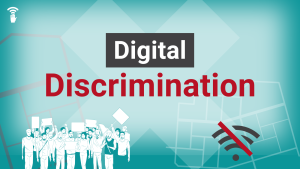In the Infrastructure Investment and Jobs Act, Congress recognized that digital discrimination is a real and present problem for many people and charged the Federal Communications Commission (FCC) with developing rules to prevent and eliminate it.
 Congress did this in connection with creating a suite of broadband programs to address the main causes of the digital divide—the lack of infrastructure, the lack of affordable and transparent internet service offerings, and the lack of digital inclusion and adoption programming.
Congress did this in connection with creating a suite of broadband programs to address the main causes of the digital divide—the lack of infrastructure, the lack of affordable and transparent internet service offerings, and the lack of digital inclusion and adoption programming.
NDIA and Common Sense Media submitted comments in response to the FCC’s recent Notice of Proposed Rulemaking (NPRM) for the forthcoming digital discrimination rules.
Digital Discrimination Can Be Unintentional
We urged the FCC to develop comprehensive rules to capture all forms of digital discrimination that deny a person equal access to broadband service and to prioritize the following in its rules:
- Digital Discrimination can be intentional or unintentional. In other words, a service provider’s unintentional practices can leave individuals and communities without equal access to broadband, and the FCC does not need to find evidence that a service provider intended to discriminate to take action to stop it.
- Consumers and their lived experience should be what drives the rulemaking process. The FCC should consistently consult with consumers and those who serve them, like digital inclusion practitioners and digital navigators, to fully understand their experiences and how the rules and processes developed can best serve them.
- The FCC should revise the consumer complaint system. The FCC should make this process easier for individuals to navigate, and organizations should be able to easily submit complaints on behalf of communities impacted by digital discrimination. The FCC should also proactively analyze the data they collect through the complaint system to look for patterns of discrimination. This information should also be available to the public.
- The FCC should leverage data to uncover patterns of digital discrimination. The FCC should evaluate data from the Broadband Data Collection (BDC), the Broadband Data Act mapping process, along with data from other sources, (e.g., the Census Bureau) to look for patterns of digital discrimination. The FCC should consider any data that is credible and relevant like the recent research published by The Markup Report and by Consumer Reports.
- The FCC should conduct outreach to ensure the public understands their rights. Once the digital discrimination rules are adopted, the Commission should conduct outreach, awareness, and education campaigns across the country to ensure communities, digital inclusion practitioners, advocates and consumers fully understand the rules, their importance, and how to navigate the complaint process. The FCC Commission should create a “Consumer Bill of Rights,” stating the rules in plain language, and launch a “Know Your Rights” campaign complete with marketing and user-friendly educational materials.
Digital Discrimination Categories
Because digital discrimination is nuanced and its full extent is unknown, it will take the FCC time to determine the full scope of its impacts and all the ways it manifests. We gave the FCC some examples of discriminatory practices to look out for:
- Pricing: For example, pricing structures that leave communities in lower income areas paying higher prices for slower internet service (e.g., tier flattening .).
- Performance: For example, when the actual speed and reliability of services offered in one area is meaningfully different than those offered in another.
- Customer service: For example, customer service practices that treat people differently based on where they live or the price of the service they subscribe to.
- Network maintenance: For example, unaddressed network degradation, outages, and network cycle upgrades occurring disproportionately in some geographic areas relative to others.
- Contract terms and conditions: For example, price and duration of service contracts, fees, available service bundle options, data caps, and promotional offerings that impact consumers differently.
- Marketing: For example, predatory practices that target low-income consumers, or other marketing practices offering discounts and perks to individuals or consumers based on protected classes.
A Special Note to the NDIA Community:
Throughout this process, community voices have guided our engagement with the FCC, and they will continue to guide our advocacy efforts going forward. To those who’ve taken the time to share experiences and expertise, we thank you. Your perspectives created the foundation for our response to the FCC in this rulemaking process.
What Happens Next?
The FCC gives the public an opportunity to reply to comments organizations have submitted to the NPRM. We will review these comments and uplift perspectives that will help the FCC create strong digital discrimination rules. We’ll also respond to comments we think are harmful and incorporate community perspectives in our response. We’ll update the community when we submit comments in this next phase.
